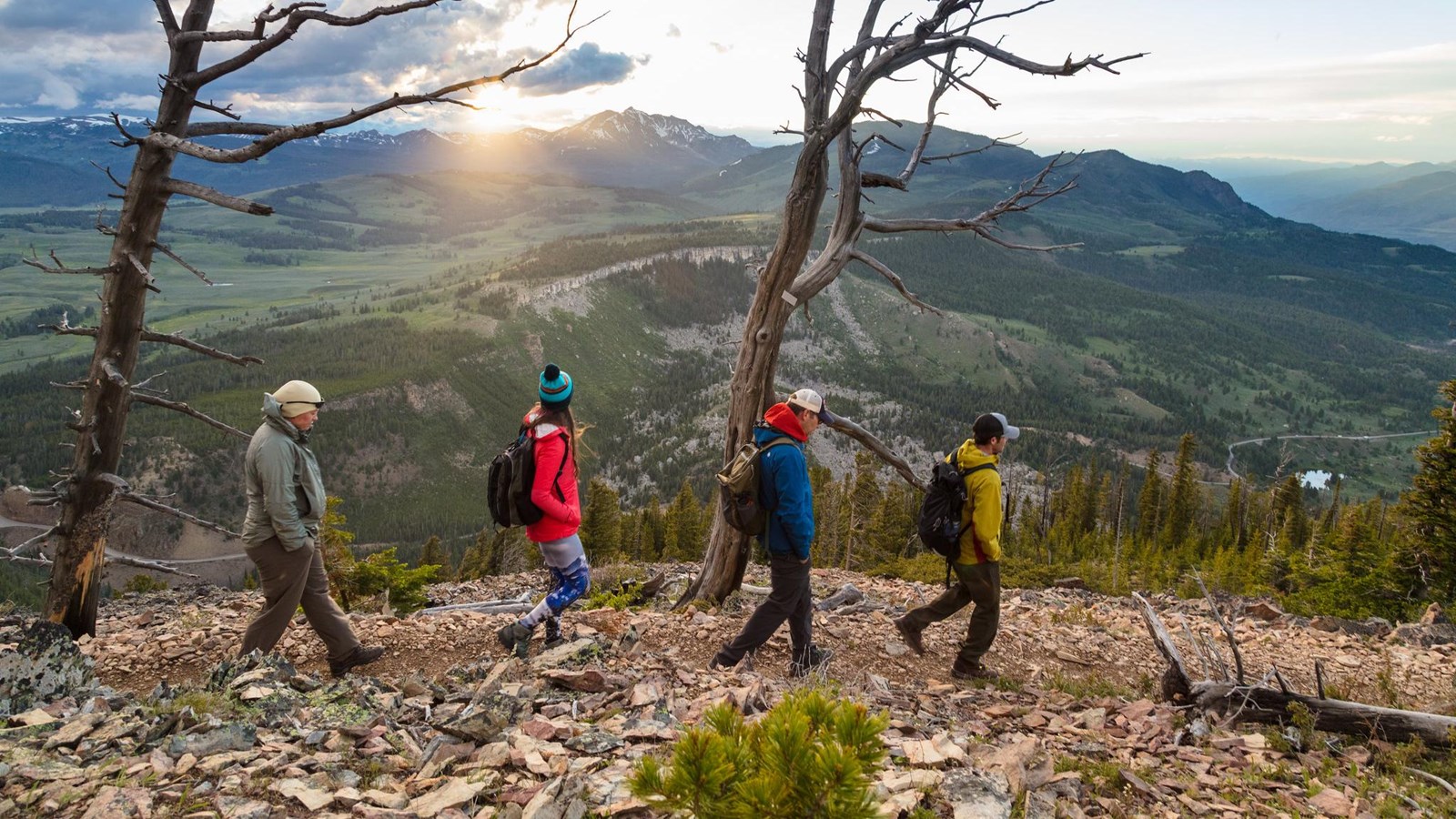Last updated: October 10, 2024
Place
Bunsen Peak Trailhead (1K4)

NPS / Jacob W. Frank
Information Kiosk/Bulletin Board, Trailhead
Bunsen Peak prominently sits south of Mammoth Hot Springs. From this trailhead, you can embark on the following trails:
- Bunsen Peak Trail
- Bunsen Peak Road Trail
- Osprey Falls Trail
Parking is limited. Winter trailhead access requires a snow coach drop-off, or skiing up from the gate at the Upper Terrace parking lot.
Bunsen Peak Trail
A moderate 4.2-mile (6.7-km) there-and-back trail to the summit of Bunsen Peak. Although this is a relatively short hike, the elevation gain is 1,300 feet (396 m) over 2.1 miles (3.2 km) of switchbacked trail. CAUTION: Grizzly bears frequent this area.
Bunsen Peak Road Trail
A 6-mile (9.6-km) one-way, moderate trail that follows an old service road curving around the southern and eastern sides of Bunsen Peak. The first 3 miles (4.8 km) are mostly level. On the northeast side of Bunsen Peak, the road becomes steep and winding, dropping 960 feet in 2.5 miles (292 m in 4 km) to Glen Creek. CAUTION: Some curves have steep drop-offs and can be hazardous when icy.
Osprey Falls Trail
A strenuous, 8-mile (12.9-km) there-and-back trail that descends into one of the deepest canyons in the park. Follow Bunsen Peak Road through grassland and burned forest 3 miles (4.9 km) to Osprey Falls Trail. Descend 700 feet (213 m) into Sheepeater Canyon. Osprey Falls, on the Gardner River, plunges 150 feet (46 m) over the edge of a lava flow. Return by the same route. Hiking, biking, skiing, and snow-shoeing allowed on Bunsen Peak Road. No bikes allowed on Osprey Falls Trail. CAUTION: Grizzly bears frequent this area.
Backcountry Regulations
Permit required for fishing, boating, riding, and overnight camping. More information at the Center Backcountry Office: (307) 344-2160.
Hiking
Hike in groups of 3 or more; keep your group together. Tell someone where you are going and when you expect to return. Know your route, carry a map, and be able to navigate. Do not hike after dark. Stay on established trails; off-trail travel prohibited in thermal areas.
Fishing and Boating
Aquatic Invasive Species (AIS) inspection required for all watercraft including boats, float tubes, and stand up paddle boards. Felt soles prohibited.
Riding and Packing
Proof of negative Coggins test within last 12 months required.
Food Storage and Camping
These regulations apply to ALL backcountry users. Sleep 100 yards (91 m) from your food storage and cooking areas. Do not leave food, trash, toiletries, backpacks, coolers, water bottles, or any potential attractant unattended. Store food in an approved bear resistant container or hang on a food pole 10 feet (3 m) above the ground and 4 feet (1 m) from sides. Carry a minimum of 35 feet (11 m) of rope. Campfires allowed only in designated campsites within established fire rings. Extinguish campfires completely before leaving site.
Follow LEAVE NO TRACE travel and camping techniques. Enjoy the backcountry and help keep it clean for others to enjoy. Bury human waste and toilet tissue in a 6–8 inch (15–18 cm) deep “cat hole” at least 100 feet (30 m) from water and trails.
River Crossings
Park waters are swift and cold. Swimming in park rivers is not recommended. River crossings are hazardous.
Lightning Safety
During thunderstorms, descend to lower elevation, avoid open areas and isolated tall trees. Assume lightning position: feet together, crouch on foam pad or sit on pack, hands over ears.
Regulations
- Leave What You Find: Do not collect anything from the park.
- No Pets: No pets on trail. Obtain service animal regulations at backcountry offices.
- No Hunting: No hunting or discharge of firearms.
- No Motorized Vehicles: No motorized vehicles on trails.
- Wheeled Vehicles Restricted: No bicycles, strollers, or wheeled vehicles (except wheelchairs), except where specified.
In an emergency, dial 9-1-1 or contact the nearest ranger station.
Animals are Dangerous
- Do not approach or feed any animal.
- Bison and elk have injured people.
- Stay 100 yards (91 m) from bears and wolves.
- Stay 25 yards (23 m) from all other animals.
Be Prepared for a Bear Encounter
Grizzly and black bears inhabit all of Yellowstone National Park.
Be Alert: Watch for signs of bear activity: scratches in trees, tracks, scat, or dig sites. Avoid dead animals.
Make Noise: Avoid surprising a bear by calling out and clapping your hands at regular intervals to make your presence known.
Carry Bear Spray: Carry bear spray and know how to use it. Keep it immediately available, not inside your pack.
Hike in Groups: Travel in groups of 3 or more is recommended. Stay with your group at all times.
What to do...
If You Encounter a Bear: Stay calm, do not run. Quietly detour or back away; stop if this seems to agitate the bear. Stay at least 100 yards (91 m) from bears. Do NOT feed bears or other animals.
If a Bear Charges You: Stand still, do not run. Stand your ground and use your bear spray. Spray when the bear is 60 feet (18 m) away or closer. If a bear charges, it may be a bluff charge.
If a Bear Makes Contact: Drop to the ground; play dead. Lie face down and clasp your hands over the back of your neck; stay still and silent. Wait several minutes after the bear leaves before getting up and leaving the area.
